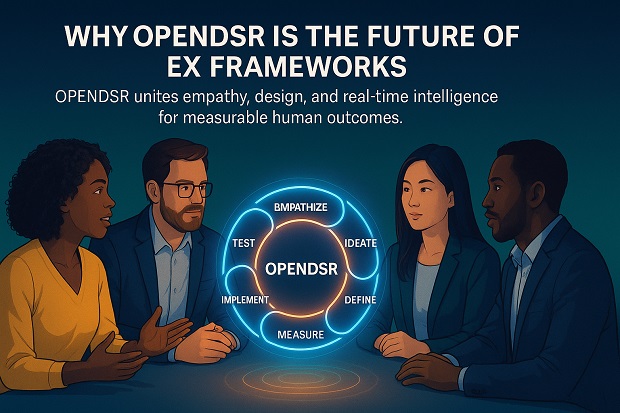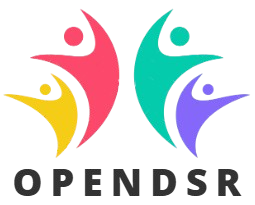
Why OPENDSR Is the Future of EX Frameworks
Why OPENDSR Is the Future of EX Frameworks
1. The Shift from Engagement to Experience Design
Employee Experience (EX) has evolved dramatically over the past decade. What began as a focus on engagement surveys and satisfaction scores has matured into a multi-dimensional understanding of how employees feel, think, and perform across their entire journey.
From Gallup’s Q12 to IBM’s EX Index and Deloitte’s Irresistible Model, the field has witnessed a surge of frameworks attempting to decode the human side of work. Yet, most still fall short in one critical way — they measure engagement, but don’t design for it.
That’s where OPENDSR comes in.
“Where traditional EX frameworks explain experience, OPENDSR designs it — dynamically, empathetically, and in real time.”
OPENDSR is not another engagement index or HR tech platform. It is a human operating framework — a continuous, adaptive cycle that unites empathy, design thinking, and intelligence loops to create experiences that evolve with people, not around them.
2. What Is OPENDSR?At its core, OPENDSR stands for:
Observe → Prioritize → Envision → Navigate → Design → Systematize → Refine
Each step builds upon the other to transform insights into meaningful, measurable, and human-centered outcomes. It blends emotional intelligence with design rigor — creating a living, learning framework that continuously listens, acts, and improves.
OPENDSR Step Purpose Core Outcome Observe Listen deeply to employee signals Build empathy through stories, not statistics Prioritize Focus on what matters most Align actions with human and business impact Envision Co-create future experiences Encourage imagination, ownership, and alignment Navigate Design the roadmap for change Translate ideas into actionable milestones Design Prototype, test, and refine Create tangible, scalable solutions Systematize Embed changes into workflows Ensure sustainability and repeatability Refine Learn continuously Keep experiences alive and adaptiveUnlike static HR frameworks, OPENDSR is circular, not linear — mirroring the organic rhythm of human experience.
3. Why Current EX Frameworks Fall ShortLet’s look at the evolution of EX frameworks — and why organizations are now seeking a next-generation model like OPENDSR.
Framework Strength Limitation Gallup Q12 Simple engagement measurement Focuses on sentiment, not design IBM EX Index Correlates EX with performance data Lacks co-creation or adaptive feedback Deloitte’s Irresistible Model Identifies key EX drivers Conceptual, not operational Forrester EX Pyramid Defines experience layers Static, doesn’t evolve dynamically Microsoft Viva / Qualtrics XM Strong data integration Technology-first, human-second OPENDSR Integrates empathy, design, and real-time loops Living system — adaptive, not prescriptiveWhile earlier frameworks mapped what drives engagement, OPENDSR operationalizes how to design it — closing the gap between insight and action.
4. The Core Innovation: Human-Centered System ThinkingTraditional frameworks focus on metrics — engagement scores, attrition rates, productivity indices. OPENDSR focuses on meaning — how experiences shape trust, flow, and belonging.
It does this through three distinct layers of intelligence:
-
Empathy Intelligence – Understanding the emotional and contextual pulse of people.
-
Design Intelligence – Translating human stories into structured interventions.
-
Real-Time Intelligence – Refining those interventions continuously through live feedback loops.
Together, these form what we call the Human Operating System (HOS) — a structure that learns from every interaction, adapts automatically, and aligns human growth with organizational purpose.
Intelligence Layer Core Function Outcome Empathy Intelligence Observes human signals and needs Builds trust and understanding Design Intelligence Structures co-creation and solutioning Creates intentional change Real-Time Intelligence Monitors, measures, and adapts Sustains continuous improvementThis triad transforms EX from a “project” into a living ecosystem.
5. Comparing OPENDSR to Traditional Frameworks Dimension Traditional EX Frameworks OPENDSR Framework Approach Linear or diagnostic Circular and adaptive Core Focus Measurement Design and action Engagement Type Passive (survey-driven) Active (co-created) Feedback Loop Periodic Continuous Human Element Quantified Humanized Ownership HR-centric Cross-functional and shared Sustainability Episodic Embedded and evolvingBy moving beyond “listen → analyze → act,” OPENDSR introduces “observe → design → refine” — turning every insight into a moment of human growth.
6. The Future of Work Demands Real-Time EmpathyThe future of work is fluid, distributed, and deeply human. Employees today expect not just feedback, but feeling — environments where their voices shape daily experiences.
The OPENDSR Advantage in a Changing Workplace Work Trend Organizational Challenge How OPENDSR Responds Hybrid Work Emotional disconnection Empathy-led signal observation Rapid Change Overwhelm and burnout Continuous refinement cycle AI & Automation Human displacement fears Human-centered design intelligence Multi-Generational Teams Misaligned expectations Shared experience co-creation Skills Evolution Obsolete capability models Dynamic, design-led upskillingIn essence, OPENDSR humanizes agility — it keeps organizations adaptable without losing empathy.
7. OPENDSR as the Operating Layer for EX TechnologyWhile platforms like Qualtrics XM, SAP HXM, or Microsoft Viva serve as experience enablers, they still require a human logic layer to interpret signals and design meaningful action.
That’s where OPENDSR fits perfectly — as the operating system layer above technology.
Technology Layer Role Tech Platforms (Viva, SAP, Qualtrics) Capture and centralize experience data OPENDSR Framework Translates data into human-centered design actions Organizational Layer Executes and refines interventions based on human feedbackThus, OPENDSR does not replace your tech stack — it amplifies its impact by embedding empathy and adaptability into its core.
8. Turning Data into Design: The OPENDSR Cycle in ActionLet’s see how OPENDSR translates listening into lasting change:
Example: Post-Merger Employee DisengagementChallenge:
A global IT firm noticed a sharp drop in engagement scores after a major merger. Surveys showed confusion, loss of trust, and identity friction.
Traditional Response (Old EX Model):
-
Conduct pulse surveys.
-
Publish engagement insights.
-
Launch leadership townhalls.
(Result: Minimal change.)
OPENDSR Response (New EX Model):
-
Observe: Conduct empathy interviews, map emotional friction points.
-
Prioritize: Identify moments of confusion (“Who do I report to?” “Where do I belong?”).
-
Envision: Co-create “Unified Culture Touchpoints” — storytelling sessions and peer listening pods.
-
Navigate: Map change pathways through design sprints.
-
Design: Build a digital onboarding and community platform.
-
Systematize: Integrate new rituals into leadership scorecards and HR workflows.
-
Refine: Monitor weekly feedback and adapt the rituals continuously.
Outcome:
Within two quarters:
-
34% increase in belonging sentiment.
-
19% drop in voluntary turnover.
-
3X higher participation in employee innovation forums.
Interpretation:
Where traditional EX frameworks captured emotion, OPENDSR transformed it.
OPENDSR creates measurable ROI not just in engagement metrics — but in trust velocity, empathy quotient, and experience adaptability.
10. Human Experience Metrics: Measuring What Moves PeopleUnlike traditional KPIs, OPENDSR measures outcomes that capture emotional and behavioral change.
Traditional KPIs OPENDSR Human Metrics Engagement Score Empathy Index Retention Rate Trust Velocity Productivity Flow Efficiency Learning Hours Adaptability Quotient Survey Response Rate Signal ResponsivenessBy tracking how quickly an organization learns from its people, OPENDSR builds a new measure of maturity: Human Experience Agility (HXA).
11. OPENDSR as a Cultural DNA FrameworkIn its mature state, OPENDSR becomes cultural infrastructure — not a project. It weaves into leadership decisions, rituals, and governance.
The Three Pillars of OPENDSR Culture:
-
Open Platform: Interoperable systems and transparent dialogue.
-
Empathy-Led Navigation: Leading with awareness, not assumption.
-
Design Standards: Coherence, clarity, and consistency across touchpoints.
Together, they form the Human OS — a culture that feels alive, learns fast, and scales responsibly.
12. Why OPENDSR Is the Future of EX FrameworksLet’s bring this comparison full circle:
Future-Ready Feature Old EX Models OPENDSR Advantage Adaptability Limited refresh cycles Built-in continuous refinement Empathy Integration Survey-based Lived empathy and co-creation Design Application Occasional workshops Systematic, ongoing process Real-Time Feedback Tool-dependent Framework-embedded Scalability Team/Function-based Enterprise-wide Human Impact Indirect Measurable and adaptiveIn short, OPENDSR represents a paradigm shift — from analyzing experiences to engineering human thriving.
13. Leadership and Governance ImplicationsTo sustain OPENDSR, organizations establish new EX governance roles that drive consistency and empathy across layers:
Role Function EX Owner Champions employee experience strategy HCX Data Steward Ensures ethical, human-centered data practices Moment Designer Curates meaningful experience touchpoints Experience Coach Guides teams through the OPENDSR cycleThese roles transform EX from a reporting function into a strategic movement within the organization.
14. The Human-First FutureIn the next decade, the most successful organizations won’t be those with the most advanced HR technology — but those with the most human operating logic.
OPENDSR is that logic.
It transforms:
-
Feedback into empathy
-
Empathy into design
-
Design into movement
-
Movement into measurable human growth
When empathy becomes operational, organizations no longer need to “manage” experience — they become it.
15. Conclusion: Designing the Human Operating SystemThe future of Employee Experience isn’t about choosing the right platform — it’s about building the right rhythm between humans and systems.
OPENDSR creates that rhythm.
It listens, learns, and evolves — uniting technology, empathy, and design into one adaptive operating system for the human enterprise.
“The future of EX isn’t measured in engagement. It’s measured in evolution.”
🔹 Summary Table: OPENDSR at a Glance Core Feature Purpose Business Outcome 7-Step Adaptive Cycle Empathy → Design → Intelligence loop Continuous EX improvement Multi-Intelligence Model Empathy, Design, Real-Time Balanced human + system insight Integration Layer Works with SAP, Viva, Qualtrics Complements existing tech Human Metrics Trust, Flow, Adaptability Measurable human outcomes Governance Roles EX Owner, HCX Steward Sustainable leadership model Final Thought:OPENDSR is not a framework — it’s a philosophy of flow.
It transforms the workplace from a process-driven system into a human-centered ecosystem that grows, adapts, and thrives with its people.








